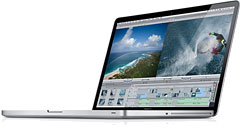Mac Musings
The 17" Unibody MacBook Pro Value Equation
Daniel Knight - 2009.01.07 -
Follow Low End Mac's blogs: LEMblog and Low End Mac Services.
Apple made some significant changes to the 17" MacBook Pro design when it announced the new model with unibody construction yesterday. This time around it's not a simple matter of a faster CPU, more RAM, and/or a bigger hard drive.

New 17" Unibody MacBook Pro
In terms of productivity, a slightly thinner, slightly lighter design isn't a big deal. The unibody design may make it more rugged, but that will have more impact on longevity than productivity - still, it does impact value.
In basic computing hardware terms, the 17" Unibody MacBook Pro is pretty much what we would have expected from the specs of the October 2008 update to the MacBook Pro and the features of the 15" Unibody MacBook Pro. We have the same 1920 x 1200 screen resolution, the same 320 GB hard drive, the same 802.11n WiFi, the same 4 GB of RAM standard as the previous 17-incher. And we have the unibody design, dual graphics processors, standard glossy display, and loss of a FireWire 400 port as the 15" Unibody.
In terms of raw processing power, the 2.66 GHz isn't a big step up from 2.5 GHz - everything else being equal, it's only 6.4% faster. But coupled with a faster system bus and incremental improvements in Intel CPU design, perhaps we'll see a 10% boost in performance. That won't have a big impact on productivity, but it will help a bit. (For productivity mavens, there's a 2.93 GHz option. That's 10% more speed than the stock CPU at a $300 premium.)
And for serious designers, the 17" Unibody MacBook Pro is Apple's only notebook with an anti-glare option. It's probably worth the extra $50.
Best Feature or Achilles' Heel?
The most controversial feature of the new 17" MacBook Pro is the battery. It packs a stunning 8 hour charge, enough to get through an entire workday. But to stuff that much power into the computer, Apple chose to build the battery into the computer; it's not user replaceable.
That's the most unquantifiable difference between the new model and all Mac notebooks that have gone before it (excepting the MacBook Air). On the one hand, 60% more battery life is a real blessing. On the other hand, even 8 hours may not be enough for some. On the third hand, the battery should continue to take a charge for five years, minimizing the need to replace it.
My inclination is to consider it a blessing. Five hours of battery life isn't bad in a notebook, but 8 hours is much better. And not needing to replace the battery for perhaps 5 years saves the $150 or so cost of a replacement battery 2-3 years down the road.
Close-out Pricing on the Old
Apple dealers need to clear out old inventory to make room for the new model. Here are today's best deals:
- 2.5 GHz, 2 GB/250, $1,900
- 2.5 GHz hi-res, 4 GB/320, $2,499 (refurbished, $2,199)
- 2.66 GHz, 4 GB/320, $2,694 after rebate
- 2.93 GHz, 4 GB/320, $3,094
Prices for the close-out Penryn models are likely to drop further as Apple offers price protection to dealers, but this at least gives us a starting point for comparison.
At these prices, the new 2.66 GHz PowerBook is easily worth the $300 difference in price - about 10% more speed, better graphics processors, and incredible battery life make it a clear-cut winner.
Comparing that with refurbished pricing, it's not as easy a decision. You'll be nearly as productive, but you won't have 8 hours of battery life, and you will probably need to replace the battery inside of three years. At $600 less, the refurb is a good deal.
All things considered, the 2.5 GHz hi-res model should be selling for at least $400 less than the new one, maybe even $500 less. Until then, the Unibody 17-incher is the value leader.
For those on a budget who want a 17" MacBook Pro, the "lo-res" model at $1,900 is a good deal, but the 15.4" Unibody MacBook Pro has exactly the same resolution in a smaller, lighter, less costly package.
Join us on Facebook, follow us on Twitter or Google+, or subscribe to our RSS news feed
Dan Knight has been using Macs since 1986, sold Macs for several years, supported them for many more years, and has been publishing Low End Mac since April 1997. If you find Dan's articles helpful, please consider making a donation to his tip jar.
Links for the Day
- Mac of the Day: iMac G5, introduced 2004.08.31. Apple put everything behind the LCD in the 17" and 20" iMac G5.
- Support Low End Mac